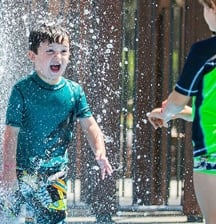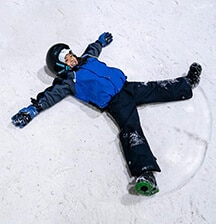
Your kids have piles of toys they’ve gotten bored of and have nothing to do? Broaden their imaginations and declutter for better play.
We are approaching another birthday in our house and all I can think is: more toys? Ahh! I find the more my daughter has, the less she plays with them. So, what can be done with all the toys and how do we make the most of what they already have? Reimagine and declutter!
What the heck do i do with that?
I have a confession: I have bought toys for my daughter just because I wanted them. The My Little Pony caf? was so cute, it even had doors that the ponies opened with their hooves: how could I not buy that? That same birthday, my husband bought her a castle with soldiers. Luckily, she likes both.
But sometimes parents excitedly buy toys, knowing exactly how we would play with it, and our kids think: what do the heck do I do with that? Our experience of the world ? real or imagined ? can make it easier for us to come up with play scenarios: the ponies can bake a cake and sell it in the caf?; the soldiers can protect the treasure as they travel through a dark forest.
Without the benefit of our experiences to provide ideas, kids sometimes need a kick start in how to play with a new toy. It can be hard for young children to think of taking Barbie for an imaginary swim, let alone using a new spaceship to discover alien planets. The more they do, see and read, the wider their play scenarios will become. For example, kids superhero capes can be an amazing toy to spark their imagination.
All they need is a cape and they’ll be off flying around pretending to shoot lasers out of their eyes, right? Well, first they need to actually WATCH a superhero film or READ a superhero comic. Then, once they have the basis for what a superhero is, they can invent their own with just a cape to give them that initial idea. Adults playing along with them, even for 5-minutes, will extend and deepen play even further. Just think how cool your kids will feel in their superhero cape if you pick them up high over your adult-height head!
This is also true for older babies and young toddlers. Don’t just plop them in front of a huge toy box. Pick out one or two toys and take the time to show them exactly what they are meant to do with it. Show them how to stack up their blocks (and watch their little face as you knock it down again) or place boxes inside one another ? don’t presume they will know what to do with them.
New toys and new play scenarios need time to develop. The same toys kept out in the lounge or bedroom for a couple of weeks can give them a chance to really build on their imaginary play. The stories become more complex, and you can add new ideas too, asking questions such as “What else does superman do?” or “Do we need anything else here?” Toys can be combined, paper gadgets made, and huts built.
Try it: Researchers in early childhood centres have observed that when adults move to an area of play, so do the kids. Choose a toy that has been forgotten about for a while. Try playing with it yourself in a way you haven’t seen your child playing before. If you need inspiration, think of some jobs people do in the community, or look through some picture books for storyline ideas. Your child will not only love playing with the toy just because you are, but will also get new ideas and inspiration to continue using later on their own.
instant toy library
If children have a lot of toys (and don’t want to part with any), starting a personal toy library system might help them to organise and make better use of what they do have. Get some storage boxes and pack away two-thirds of the toys, then rotate fortnightly. When you bring a new box out of storage, ta da!? Toys that were long forgotten or boring are suddenly seen in a new light. If you’re feeling super-organised, you could even put them all away and let the kids choose their own toys for the fortnight, just like a real toy library.
Be careful though about how and where toys are stored. Unlined garages and cardboard boxes can be very susceptible to mould and insect problems: no-one will be happy if all the costumes and Barbie dolls come out smelly and moth-eaten. Paper and fabric toys in particular need very careful storage. Dry areas that don’t vary much in temperature are best.
Before buying any more toys, consider actually joining the local toy library. You can try out toys and then give them back just as the kids start to lose interest. With 1- to 3-year-old children, who are rapidly changing developmentally, toy libraries can save you a lot of money. They are also especially useful for both large and seasonal toys that are difficult to store and expensive to buy.
see ya later, fluffy alligator
Next time you go on a holiday or day trip, leave behind the toys, iPod, TV, cell phones (or only take an emergency one) and games, and see what happens. The kids might be bored for a while, but they will soon re-discover their imaginations. Children play creatively all around the world with nothing more than what nature has provided. When I was young, a memorable holiday involved creating a game jumping over sticks: it was simple, it was physical, and we played it for days, adding rules as we went.
Without toys, a pile of stones and circles of dirt become Mancala (if you haven’t heard of this game, it’s worth a web search), obstacle courses get invented, charades and plays are performed, and improvised instruments are discovered. Younger children pretend more, older children create more, and everyone explores more. Go on. Be brave. It’s worth it!
The more they do, see and read, the wider their play scenarios will become; but adults playing with their children, even for 5-minutes, will extend and deepen play at any age.
Alternatively, taking only craft supplies and board games on holiday creates another type of play. This may be a good toy-free solution for winter or urban holidays.
Try it: If there are three or more people, then playing a few games such as this one below may help reluctant kids get into fun-without-toys mode:
Sit one child blindfolded with lots of sticks around them. Everyone else take turns (one or two at a time) to creep up, attempt to steal a stick, and take it back ?home’ without being heard. If the blindfolded child hears a noise, they point in that direction. Anyone who was correctly pointed at has to leave the stick and go back home. Sticks can be counted at the end to see who has the most.
QUESTIONS TO ASK WHEN BUYING TOYS:
1. Can this toy be used imaginatively?
2. Will it add to play?
3. Does it do it all for them? (Ask these questions especially before buying toys that require batteries!)
KELLY EDEN-CALCOTT IS A MOTHER OF THREE AND FREELANCE WRITER, TRAINED IN EDUCATION AND CHILD DEVELOPMENT.
more entertainment and games from tots to teens:








